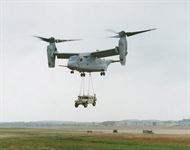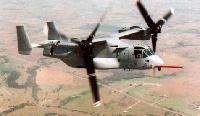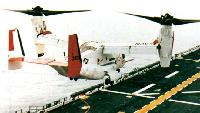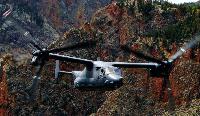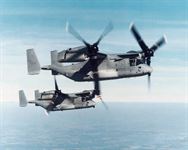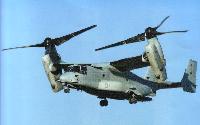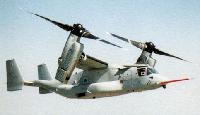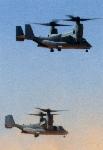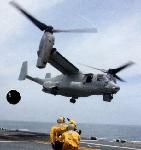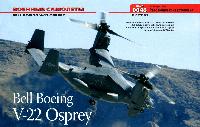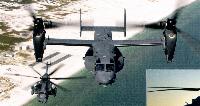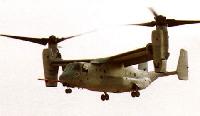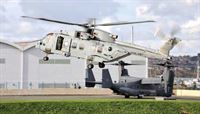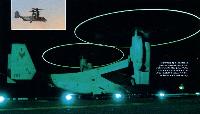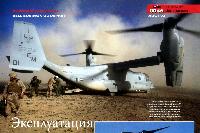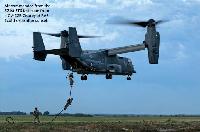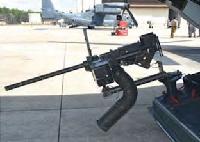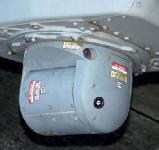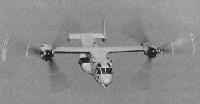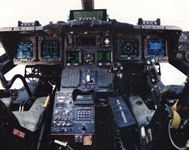
Описание
Страна : США
Год : 1989
Конвертоплан
Многоцелевой конвертоплан на земного и корабельного базирования с экипажем из трех или четырех человек
Варианты
- Bell - XV-15 / Model 301 - 1977 - США
- Bell/Boeing - V-22 Osprey - 1989 - США
- Bell - V-280 Valor - 2017 - США
Bell Boeing V-22 Osprey (Model 901)
В начале 1980-х годов "Bell" и "Boeing Vertol" объединили усилия с целью создания в рамках программы "единого перспективного самолета с вертикальным взлетом и посадкой" (JSAVLA, ранее - JVX), реализуемой Минобороны США, экспериментального конвертоплана XV-15. Идея заключалась в том, чтобы создать летательный аппарат, который сочетал бы в себе достоинства вертолета (возможность взлетать и садиться вертикально на ограниченных площадках) и обычного самолета (высокая крейсерская скорость и большая грузоподъемность). В конечном итоге разработчики представили конвертоплан Bell Boeing Model 901, в дальнейшем получивший обозначение V-22 Osprey.
В состав силовой установки V-22 включили два ТВД Allison T406-AD-500, установленных в поворотных гондолах на законцовках крыла. Двигатель имеет модульную конструкцию и работает на трехлопастный воздушный винт, а гондола может поворачиваться на 97.5°. Для уменьшения ИК-заметности на обоих двигателях установлена система охлаждения выхлопных газов и экранирования горячих частей двигателя.
В июне 1985 года ВМС США выдали разработчикам контракт на полномасштабную разработку нового летательного аппарата, который предусматривал постройку шести прототипов, а также нескольких образцов для проведения статических испытаний. "Bell" отвечала за разработку и выпуск крыла, рампы, гондол двигателей, трансмиссии, хвостовой секции, воздушного винта и сопутствующих систем, а также за установку двигателей, тогда как "Boeing" взяла на себя работы по фюзеляжу и всем подсистемам, шасси, ЭДСУ и интеграцию комплекса цифровой авионики. Композитные материалы достигают в конструкции конвертоплана до 59% ее массы.
Первоначально ВС США выразили заинтересованность в приобретении 913 конвертопланов: 552 транспортно-десантных MV-22A, способных перевозить 24 десантника, для КМП США и еще 231 аналогичную машину для Армии США; 80 CV-22A для подразделений сил специальных операций ВВС США и 50 поисково-спасательных HV-22A, способных брать полезную нагрузку до 9072 кг, для ВМС США. Кроме того, американские адмиралы рассматривали возможность приобретения еще порядка 300 конвертопланов V-22 в противолодочном варианте. Конвертопланы корабельного базирования имеют крыло, которое может поворачиваться на 90°, как бы укладываясь на фюзеляж. Также складываются лопасти воздушных винтов.
"Bell" и"Boeing " отвечали за сборку и начальные летные испытания трех прототипов каждая. "Bell" подняла свой конвертоплан 19 марта 1989 года, а 14 сентября 1989 года на V-22 в полете был впервые выполнен переход из режима "по-вертолетному" в режим "по-самолетному". Другие две машины "Bell" поднялись в воздух 9 августа 1989 года и 9 мая 1990 года. "Boeing" подняла свои конвертопланы - четвертый и пятый прототипы - 21 декабря 1989 года и 11 июня 1991 года. Постройка шестого прототипа закончена не была. Пятый прототип получил серьезные повреждения во время своего первого же полета, а 21 июля 1992 года произошла катастрофа с четвертым прототипом - погибли семь человек. В 1992 году программа была заблокирована конгрессом.
Летные испытания были возобновлены только в июне 1993 года, но к тому времени все заказчики - кроме КМП США - отказались от своих намерений, так что на середину 1992 года общий объем заказов по программе V-22 составлял всего 300 машин, но с опционом еще на 300 или даже 500 единиц. В конечном итоге объем заказа составил 425 конвертопланов, предназначенных для замены вертолетов CH-53 и CH-46, а в августе 1993 года V-22 был определен КМП США в качестве единственного летательного аппарата, удовлетворяющего их требованиям.
Запуск V-22 в серийное производство был одобрен в сентябре 1994 года, первой стали собирать модель MV-22A - его поставки в КМП США начались в середине 1999 года. Другие модификации, разрешенные к серийному производству: HV-22A - 48 машин должны поставляться ВМС США с 2010 года, и CV-22A - 50 таких конвертопланов поставляются силам специальных операций ВВС США.
Во время войсковых испытаний было потеряно еще два Osprey, что наряду с изрядно возросшей стоимостью программы, послужило причиной приостановки ее реализации. Однако работавшие в течение 18 месяцев комиссии пришли к выводу, что конвертоплан V-22 по-прежнему является единственным летательным аппаратом, наилучшим образом удовлетворяющим требованиям КМП США, и что разработка в сжатые сроки нового ЛА с аналогичными или лучшими характеристиками экономически невозможна.
В мае 2002 года Osprey вернулся в небо, продолжилось и производство малыми сериями: MV-22 - для КМП, a CV-22B - для спецназа ВВС. Однако заявка ВМС на поисково-спасательные HV-22B по состоянию на лето 2009 года профинансирована не была.
28 августа 2003 года была сформирована испытательная эскадрилья конвертопланов в составе авиации КМП - VMX-22, которая в 2005 году принимала активное участие в серии различных испытаний и показательных учений. В сентябре 2005 года была сформирована учебная эскадрилья, VMMT-204, а в апреле 2006 года состояния "полной оперативной готовности" достигла эскадрилья VMM-263. Затем командование КМП приняло решение направить часть Osprey в Ирак - 10 конвертопланов из состава VMM-263 были переброшены на авиабазу Аль-Ассад в октябре 2007 года.
В рамках подпрограммы CV-22B для ВВС США два конвертоплана MV-22 были модифицированы до стандарта CV-22B и использовались для испытаний. Первые два CV-22B были поставлены заказчику 19 сентября и 27 октября 2005 года, они поступили в 58-е авиакрыло спецназначения, летчики которого начали подготовку на авиабазе Киртлэнд с августа 2006 года. В ноябре 2008 года командование ВВС США направило группу из четырех CV-22 в Мали, а официально о достижении конвертопланом состояния "начальной оперативной готовности" командование ВВС объявило 16 марта 2009 года. Поставки в ВВС запланированы на 2017 год.
Следует отметить, что ВВС остались неудовлетворены набором вооружения, устанавливающимся на вариант для морской пехоты, и впоследствии выдали компании "BAE Systems" подряд на разработку для своих CV-22B специальной установки под шестиствольный скорострельный пулемет Minigun, а также комплекта соответствующего оборудования. Пулеметная установка монтируется в люке, сооруженном в днище и используемом обычно десантниками для быстрой высадки с помощью троса. Однако по состоянию на середину 2009 года данная система еще находилась в стадии разработки.
ТАКТИКО-ТЕХНИЧЕСКИЕ ХАРАКТЕРИСТИКИ
Bell Boeing MV-22A Osprey
Тип: многоцелевой конвертоплан на земного и корабельного базирования с экипажем из трех или четырех человек
Силовая установка: два ТВД Allison T406-AD-400 мощностью по 6150л.с. (4586 кВт)
Характеристики (оценка): максимальная крейсерская скорость на уровне моря в режиме "по-вертолетному" 185 км/час или на оптимальной высоте в режиме "по-самолетному" 582 км/час; начальная скороподъемность 707 м/мин; практический потолок 7925 м; статический потолок без учета влияния земли 4330 м; дальность полета при высадке морского десанта 935 км или 3892 км - перегоночная при взлете с коротким разбегом
Масса (оценка): пустого 15032кг; максимальная взлетная 21546 кг (при вертикальном взлете) или 27 443 кг (при взлете с коротким разбегом)
Размеры: максимальная ширина 25,55 м; размах крыла без гондол двигателей 14,02 м; диаметр воздушного винта 11,58 м; длина без штанги 17,4/ м; высота с поднятыми двигателями 6,63 м; площадь крыла 35,49 м:; площадь, ометаемая воздушными винтами (общая) 210,72 м'
Вооружение: вероятно - один или два 12,7-мм трехствольных пулемета
Полезная нагрузка: до 24 десантников, или 12 раненых на носилках с сопровождающими санитарами, или 9072 кг груза в кабине или же 6804 кг на внешней подвеске
- Описание
Фотографии
-
Мировая Авиация 173
V-22 Osprey. Идея создания летательного аппарата нового класса - конвертоплана - обсуждалась достаточно длительное время, пока авиаконструкторы не пришли к выводу, что создание такой машины стало технически возможным. Достоинства конвертоплана очевидны: возможность выполнять все маневры вертолета и осуществлять горизонтальный полет как самолет - в два раза быстрее вертолета. Изображен второй опытный аппарат.
-
Мировая Авиация 13
19 марта 1989г.: достигнут значительный прогресс в программе создания одного из самых необычных летательных аппаратов в истории авиации - первый полет выполнил конвертоплан Bell/Boeing V-22 Osprey.
-
Air International 1989-05 / ??? - Osprey: Tilting at Convention
The first example of the Bell-Boeing Osprey to fly is one of six prototypes in the full-scale development (FSD) batch, and is devoted to basic performance and flight behaviour. Although Bell is assembling four of the FSD airframes and Boeing only two. each company will handle the flight testing of three V-22s. Some 4,000 hrs will be flown on the six aircraft prior to the Osprey’s acceptance by the armed forces.
-
Air Enthusiast 2006-09 / D.Willis - V for Variety /Air forces/ (3)
YV-22A 163913 was the third FSD aircraft.
-
Jane's All the World Aircraft 2000 / 2-08 - AIRCRAFT - TILT-ROTOR - MILITARY/CIVIL
Second EMD Bell Boeing V-22 demonstrates carriage of underslung load comprising an HMMWV at Patuxent River (1999)
-
Air Pictorial 1990-02
Two V-22 Ospreys flew in formation for the first time last November at Arlington, Texas, during scheduled test flights for initial handling qualities evaluation. The photo shows Aircraft Number One flying in the ordinary aircraft mode past Aircraft Number Two which remains in the helicopter mode. By the time of this photograph both aircraft had flown for a total of 48 flights accumulating more than 28 total flight hours. Speeds of over 300 mph true air speed, altitudes of more than 10,000 feet, 2.3 G load factors, turns, simulated one engine operation and stalls at 0 degree and 20 degree flaps had also been achieved. Bell Helicopter Textron's V-22 Project Pilot Dorman Cannon and Boeing Helicopters' Project Pilot Dick Balzer were at the controls of Aircraft One during this milestone flight. Pilots for Aircraft Two were Boeing's Ray Dunn and Bell's Roy Hopkins.
-
Air International 2002-07 / Airscene
Bell Boeing MV-22 Osprey 164942 (c/n 90010) seen on its first flight from NAS Patuxent River, Maryland on May 29, 2002 over 17 months after the type was grounded following a fatal crash on December 11, 2000. The aircraft has been extensively modified with improvements to its hydraulic and flight control software systems.
-
Мировая Авиация 173
Osprey может осуществлять полет как обычный самолет - с большей скоростью и на большую дальность, чем вертолеты.
-
Air Enthusiast 2006-09 / D.Willis - V for Variety /Air forces/ (3)
At one point it was hoped that the V-22 Osprey would be in service with the Marines by the mid-1990s. Of the original five FSD aircraft two were written-off, although 162912 (illustrated) survived to be struck-off charge on March 24,1999.
-
Aeroplane Monthly 2000-01 / P.McDonnell - Requiem for the Rotodyne /Type history/
The first examples of the Bell-Boeing V-22 Osprey tiltrotor will be operational with the US Navy and US Marine Corps by 2004, and the aircraft is actively being marketed overseas. A response to this effort has come from the Royal Navy and Royal Air Force, which are currently evaluating the type with a view to replacing their Sea Kings and Pumas. Bell-Boeing is certain that the Osprey will be able to fulfil all the roles intended for this innovative aircraft.
-
Мировая Авиация 173
Испытания V-22 на корабле УДК "Уосп" прошли 4-7 декабря 1990 года. Тогда же провели испытания системы дозаправки топливом в полете.
-
Air Enthusiast 2006-09 / D.Willis - V for Variety /Air forces/ (3)
Third FSD YV-22A 163913 during carrier compatibility trials.
-
Air International 1989-05 / ??? - Osprey: Tilting at Convention
As preparations for the first flight of the Bell-Boeing V-22 Osprey continued at Bell’s Flight Research Center in Arlington, Texas, the prototype made its first engine runs on 28 December 1988.
-
Air International 1989-05 / ??? - Osprey: Tilting at Convention
Rolled-out at Arlington, Texas, on 23 May 1988, the Osprey prototype shown here, which is actually an MV-22A in the configuration of the Marines’ assault transport version, was finished for the occasion in operational-style camouflage. It has subsequently reverted to an all-white finish for the initial test flight phase.
-
Мировая Авиация 55
12 декабря 1990г.: на борту американского корабля "Васп" (LDH-1) начались летные палубные испытания двух прототипов конвертоплана V-22 Osprey.
-
Air International 2006-08 / F.Colucci - Ospreys Hover Into View /Military/
Operational test and evaluation is being carried by the first production representative aircraft at Kirtland Air Force Base, New Mexico. USAF CV-22A is seen in helicopter mode over the White Sands.
-
Air International 2020-04 / Rotary Focus
The first CMV-22B Osprey has been delivered to Naval Air Station Patuxent River for developmental testing. Bell Boeing hosted a reveal ceremony in Amarillo, Texas to commemorate first delivery.
-
Air International 2020-08 / Focus: UAV, Rotary, Business, Technology
North Island-based VRM-30 operates the initial US Navy CMV-22B Osprey BuNo 169437.
-
Air International 2020-04 / R.Burgess - Naval Aviation the Next Decade
The maiden flight of the first CMV-22B took place at Bell’s facility in Amarillo, Texas, in December 2019.
-
Air International 2021-01 / Focus: UAV, Rotary, Business, Technology, GA
A CMV-22B from VRM 30 lands on the aircraft carrier USS 'Carl Vinson'
-
Air International 2021-04 / News: Commercial, Military
US Navy CMV-22B Osprey 169440 ‘33’ operated by Fleet Logistics Multi-Mission Squadron 30 (VRM-30) 'Titans' lands on USS Nimitz(CW 68) on February 25, 2021. It brought Secretary of Defense Lloyd J Austin III for a visit while the carrier was in the Pacific. Four further USN CMV-22Bs were ordered on February 26
-
Air International 2007-11 / News: Headline, Military, Civil, Airshow, Accidents
USMC MV-22B Osprey 165852 'EG-OO' from VMM-263 'Thunder Chickens' prepares to take off from the amphibious assault ship USS Wasp (LHD 1) in the Gulf of Aquaba, just off Jordan, on October 4, 2007 prior to flying across Jordan and into Iraq, where the squadron's ten Ospreys are to be based at Al Asad Air Base.
-
Air International 2012-04 / H.-P.Grolleau - Forward Presence /Military/
The advent of the MV-22B Osprey has clearly marked a new era in terms of expediency when conducting an assault ashore.
-
Air International 2007-08 / News: Headline, Military, Civil, Airshow, Accidents
US Marine Corps/VMX-22 MV-22B 166391, appropriately coded 'MV-22', seen after landing on Royal Navy aircraft carrier HMS Illustrious on June 10, 2007 off the east coast of the USA. This was the first time a V-22 had embarked on a non-US vessel anywhere in the world and was a prelude to a US-led Joint Task Force Exercise (JTFX) on the eastern seaboard of the US. The JTFX will also see up to 16 USMC AV-8B Harriers embarked on Illustrious, together with 200 US personnel.
-
Air International 2007-09 / D.Carrara - A Bold Step for Illustrious
During its time off the US East Coast, Illustrious hosted three visits by a USMC MV-22B Osprey. This was the first time the type had visited a ship from another nation.
-
Air International 2022-03 / S.Gourley - High Society
A CV-22 Osprey lands at Melrose Air Force Range, New Mexico, during a visit from US Army Gen Joseph L Votel, commander of US Special Operations Command, in 2015
-
Авиация и Время 2005-05
19 сентября 2005г. в распоряжение ВВС США поступил первый из 50 заказанных самолетов вертикального взлета и посадки - конвертоплан с поворотным крылом Bell/Boeing CV-22 Osprey, предназначенный для использования Командованием специальных операций
-
Air Enthusiast 2006-09 / D.Willis - V for Variety /Air forces/ (3)
EMD MV-22 164941, dispensing flares, was converted as the first CV-22 development aircraft for the VS Special Operations Command.
-
Air International 2013-10 / News
An F/A-18A+ Hornet formates with a drogue trailed by Beil-Boeing MV-22B Osprey N204TR during the first tanker demonstration flight by the tiltrotor.
Другие самолёты на фотографии: McDonnell Douglas F/A-18C Hornet - США - 1986
-
Мировая Авиация 147
Конвертоплан CV-22 Osprey принимает топливо от MC-130P Combat Shadow из 67-й эскадрильи специального назначения, Мали, конец 2008 года. Самолет C-130 поступил на вооружение на 53 года раньше, чем конвертоплан V-22.
Другие самолёты на фотографии: Lockheed HC-130 / KC-130 / MC-130 - США - 1959
-
Air International 2006-08 / F.Colucci - Ospreys Hover Into View /Military/
On June 19, 2006 two Ospreys from the Marine Tilt-rotor Operational Test and Evaluation Squadron 22 (VMX-22) flew 2,100nm from their base at New River, North Carolina to Miramar, California. The flight was in preparation to fly across the Atlantic for the Royal International AirTattoo and Farnborough International Air Show in July.
Другие самолёты на фотографии: Lockheed HC-130 / KC-130 / MC-130 - США - 1959
-
Air International 2012-08 / R.Dorr - Kings & Commandos /Military/
An Air Force Special Operations Command CV-22 Osprey refuels from the right-hand side pod of an HC-130J. Each of the HC-130J's two refuelling stations consist of a Sargent Fletcher 48-000-6 refuelling pod, 93ft of hose, an MA-3 or MA-3-1 reception coupling and either a 27in diameter high-speed fixed wing or 54in diameter low-speed helicopter para-drogue.
Другие самолёты на фотографии: Lockheed C-130J Super Hercules - США - 1996
-
Air International 2017-11 / D.Isby - The Business End: Tankers and their Air Refuelling Systems /Military/
A US Marine Corps MV-22B Osprey refuels during a mission in support of Weapons and Tactics Instructor course 1-17 at Marine Corps Air Station Yuma, Arizona.
-
Air International 2021-07 / S.Gourley - V for Valor
Tilt-rotor platforms do have some range and speed advantages over current conventionally configured helicopters
-
Air International 2017-04 / R.Niccoli - Special Ops /Military/
A CV-22 Osprey approaches a drogue on the end of the hose extended from a MC-130H Combat Talon II during a training mission.
-
Air International 2018-03 / G.Kromhout - Always ready /Military/
A CV-22B receiving fuel in glorious weather conditions over the North Sea.
-
Air International 2018-03 / G.Kromhout - Always ready /Military/
A Combat System Operator.
-
Air International 2016-11 / D.Isby - Air Force Problems & Aspirations /Military/
Lieutenant General Brad Webb, Commander of Air Force Special Operations Command has considered the potential for a follow-on buy of CV-22 Ospreys to replace attrition. The CV-22 Osprey has become the workhorse of the AFSOC fleet since it achieved initial operational capability in March 2009.
-
Air International 2012-11 / News
MV-22B Osprey squadrons are now forward deployed to Japan and will soon be based in Hawaii.
-
Мировая Авиация 175
CV-22 следует на малой высоте над местностью со сложным рельефом. Osprey - слишком скоростная машина для того, чтобы его сопровождали боевые вертолеты, так что рассматривается возможность использования вооруженных конвертопланов BA609.
-
Авиация и Время 2006-04
Серийный MV-22 Osprey в полете над Лондоном. Июль, 2006г.
-
Air International 2006-08 / F.Colucci - Ospreys Hover Into View /Military/
This close-up view of a CV-22A clearly shows the Raytheon AN/APQ-174D terrain-following radar (housed in the thimble radome offset to port on the nose) and the chin-mounted Raytheon AN/AAQ-27 forward-looking infra-red turret.
-
Air International 2011-04 / T.Carlson - Osprey Nest West /Military/
The V-22 prop arc diameter is an impressive and unique aspect of the aircraft. Pilots are trained to keep that in mind when performing aerial refuelling.
-
Air International 2011-04 / T.Carlson - Osprey Nest West /Military/
The Osprey excels at low-level and deep penetration operations, exploiting its speed, range, and aerially refuelling capability.
-
Air International 2001-07 / R.Braybrook - Today's future classics /Technology/
This view of the V-22 in ‘conventional’ flight clearly illustrates the large three-bladed rotors designed to satisfy the disparate requirements of efficiency in the hover and cruising in forward flight.
-
Air Enthusiast 2006-09 / D.Willis - V for Variety /Air forces/ (3)
The fabulous V-22 Osprey
-
Air International 2011-04 / T.Carlson - Osprey Nest West /Military/
A significant number of US Marine Corps squadrons are yet to transition to the Osprey, with VMM-161 being the first to do so on the US west coast.
-
Air International 2011-04 / T.Carlson - Osprey Nest West /Military/
A pair of US Marine Corps MV-22B Ospreys bank over the desert. These two aircraft have not been retrofitted with air-to-air refuelling probes. Later models will have them fitted before delivery.
-
Jane's All the World Aircraft 2000 / 2-08 - AIRCRAFT - TILT-ROTOR - MILITARY/CIVIL
Two of the four EMD Bell Boeing V-22 Ospreys in close formation (1999)
-
Air International 2018-03 / G.Kromhout - Always ready /Military/
The CV-22 Osprey conducts long-range infiltration, exfiltration and resupply missions for special operations forces.
-
Air International 2006-08 / F.Colucci - Ospreys Hover Into View /Military/
VMMT-204 is the only Fleet Replacement Squadron (FRS) tasked with training V-22 aircrews and maintainers. Currently, the unit is training Osprey aircrews from the marines, as well as the navy and airforce. MV-22, 165943, was photographed over the beach close to MCAS New River. With its engines in the horizontal position, as demonstrated here, the MV-22 has a maximum level speed of 275kts.
-
Авиация и Космонавтика 2023-11 / М.Никольский - Что Запад противопоставит «Аллигаторам» и «Восьмеркам»?
Конвертоплан V-22 «Оспри» в крейсерском полете
-
Air International 2014-12 / News
US Marine Corps Bell-Boeing MV-22B Osprey BuNo 168226/‘EH-06’ from Marine Medium Tiltrotor Squadron 264 ‘Black Knights’, operating with the Special Marine Air-Ground Task Force-Crisis Response Africa detachment at Moron, Spain, flies over Liberia on October 13, 2014 to conduct surveys as part of Operation United Assistance, the US effort to respond to and contain the outbreak of the Ebola virus in West Africa. Four MV-22Bs and two KC-130Js from SPMAGTF-CR deployed to Monrovia, Liberia, on April 9 to support the mission.
-
Air International 2000-02 / F.Colucci - Sneak, Sense, Confound and Survive /Military aviation/
Like the US Marine Corps MV-22 Osprey, the USAF CV-22 tilt rotor is scheduled to receive the AAR-47. However, the choice of a directed IR jammer could introduce the AAR-57 or AAR-54 into CV-22 plans.
-
Air International 2001-07 / R.Braybrook - Today's future classics /Technology/
Note the inclined engine nacelles to reduce speed for the para-drop. A larger tilt rotor development, under consideration by Eurocopter and Agusta-Westland, is understood to differ conceptually from the V-22 in the sense that its wingtip-mounted engines remain fixed, while the rotors are tilted.
-
Авиация и Космонавтика 2007-04 / ??? - Red Flag 2007
Red Flag 2007
-
Авиация и Космонавтика 2012-09 / И.Кудишин - Авиасалон "Фарнборо-2012": регресс с инновациями
Конвертоплан Корпуса морской пехоты MV-22 "Оспри"
-
Мировая Авиация 173
При подходе к точке высадки Osprey начинает переход из самолетного режима в вертолетный - путем поворота гондол с двигателями.
-
Air International 2016-04 / News
Marine Medium Tiltrotor Squadron 261 (VMM-261) ‘Raging Bulls’ is currently deployed to Moron Air Base, Spain with the Special Purpose Marine Air-Ground Task Force for Crisis Response in Africa. The squadron’s flagship MV-22B BuNo 168303/EM00 is seen at Cannes Airport, France during a recent training exercise. The tail is marked with the Gadsden flag comprising a rattle snake and the legend ‘Don’t Tread On Me’. The flag was designed in 1775 by General Christopher Gadsden during the American Revolution, and used by the Continental Marines as an early motto flag.
-
Air International 2017-06 / Airscene
MV-22B Osprey BuNo 168341/YX00 assigned to Marine Tiltrotor Squadron 166 (VMM-166) ‘Sea Elks’ participated in WTI 2-17 at Marine Corps Air Station Yuma, Arizona during April 2017. Various weapon options are under consideration by the US Marine Corps to give the MV-22 the capability to counter enemy fire in a landing zone.
-
Air International 2018-10 / Airscene
An MV-22 Osprey, assigned to Air Test and Evaluation Squadron 21 (HX-21), demonstrates its ballast dump system while operating from the aircraft carrier USS George H.W. Bush (CVN 77).
-
Air International 2013-10 / News
Among four Bell-Boeing MV-22B Ospreys recently deployed to Moron AB in Spain was BuNo 168230/‘YS-01’ (c/n D0180), the flagship of Marine Medium Tiltrotor Squadron 162 (VMM-162) ‘Golden Eagles' based at MCAS New River, North Carolina. The tiltrotors arrived on August 17, 2013. The Spanish base supports Osprey deployments for potential rapid response operations in northern Africa.
-
Air International 2013-06 / News
On April 26, 2013 six Bell-Boeing MV-22B Ospreys of Marine Medium Tiltrotor Squadron 365 (VMM-365) 'Blue Knights' arrived at Moron AB in Spain, accompanied by two Lockheed Martin KC-130J Hercules tanker transports of Marine Aerial Refueler Transport Squadron 252 (VMGR-252) 'Otis’ (BuNos 168069/'BB-069' and 165810/'BH-810‘) based at MCAS Cherry Point, North Carolina. Up to 500 US Marines will be deployed at Moron to provide a rapid reaction force, primarily to cover potential operations in northern Africa. Around 225 will support the Ospreys, while another 225 will be combat, intelligence and communications personnel. The 'Blue Knights' are based at MCAS Miramar, California, and MV-22B BuNo 165850/'YM-00' (seen here) is the unit's flagship, carrying the squadron's marking in colour on its tail. The other five deployed tiltrotors are BuNos 166721/‘YM-W, 168225/'YM-12', 166718/'YM- 02', 166609/'YM-04‘ and 166719/'YM-09', the latter wearing special tail markings for Marine Wing Support Squadron 272 'Untouchables' - an aviation ground support unit.
-
Мировая Авиация 112
V-22 стал первым успешным конвертопланом, принятым на вооружение ВС США и запущенным в массовое производство. Первые боевые потери парк Osprey понес в 2010 году в Афганистане.
-
Air International 2015-02 / News
A US Marine Corps MV-22B Osprey assigned to Marine Operational Test and Evaluation Squadron 22 (VMX-22) ‘Argonauts' takes off from the flight deck of amphibious assault ship USS Wasp (LHD 1). The squadron and its Ospreys are scheduled to move to Marine Corps Air Station Yuma, Arizona, during the summer of 2015.
-
Air International 2011-10 / News
Bell Boeing MV-22B Osprey BuNo 166491/70' (c/n D0070) of Air Test and Evaluation Squadron 21 (HX-21) 'Blackjack' based at NAS Patuxent River, Maryland, has recently been used in a series of biofuel test flights. The tiltrotor was flown using a blend of 50-50 camelina-based biofuel and standard JP-5. It is seen during one of the flights on August 10, 2011.
-
Air International 2006-08 / News: Headline, Military, Civil, Accidents, Airshow
A highlight of the Tattoo was the first UK public appearance of two Bell Boeing MV-22B Ospreys, one of which participated in the flying display and the other was on static exhibition. The two aircraft are on the strength of the US Marine Corps VMX-22 Test Squadron and flew from their home base of New River, North Carolina to Farnborough, Hampshire, with in-flight refuelling provided by KC-130J Hercules. After a short take-off, with the engines tilted at 60°, the Osprey demonstrated its helicopter (engines vertical) and conventional (engines horizontal) modes. Apart from its unconventional configuration, the lightweight paint (being tested) and low noise output were particularly noteworthy.
-
Мир Авиации 2006-02 / Д.Комиссаров - RIAT 2006: праздник на любой вкус /Своими глазами/
MV-22B "Оспри" борт 166391/MV-22 Корпуса морской пехоты США (зав. N 90061) на режиме висения.
-
Air International 2007-05 / R.Burgess - US Marine Corps /Military/ (2)
Bell-Boeing MV-22Bs are starting to replace CH-46Es, with the US Marine Corps intending to purchase 360 Ospreys. The silver scheme is being trialled as the paint weighs less than the grey currently in use and has a reduced infra-red signature.
-
Air International 2017-07 / Airscene
US Marine Corps MV-22B BuNo 168011/YP00 is the colour bird of Marine Medium Tiltrotor Squadron 163 (VMM-163) based at Marine Corps Air Station Miramar, California seen at King County Airport, Seattle on June 2, 2017.
-
Air International 2011-09 / News
Bell Boeing has submitted a second multi-year buy of V-22 Ospreys. This example is MV-22B BuNo 168011/'PH00' operated by Marine Medium Tiltrotor Squadron 561 (VMM-561) 'Pale Horses'.
-
Мировая Авиация 175
В 2009 году MV-22B авиации КМП США приняли участие в операции "Bright Star" - совместном американо-египетском учении.
-
Air International 2011-04 / T.Carlson - Osprey Nest West /Military/
A pair of VMM-161 Ospreys on final approach to Kirtland AFB, New Mexico. The unit recently trained with Air Force CV-22s in the local ranges.
-
Air International 2014-03 / N.Pittaway - Rapid Responders /Military/
MV-22Bs from the 31st MEU at the Shorewater Bay Training Area during Talisman Saber 2013.
-
Air International 2014-05 / News
Two Beil-Boeing MV-22B Ospreys, led by BuNo 168230/‘YS-01’, about to land at the Tifnit military installation in Morocco on April 4, 2014 during Exercise African Lion 2014.
-
Air International 2021-11 / Focus: UAV, Rotary, Business, Technology, Space
US Air Force 1st Special Operations Wing CV-22 Ospreys from Hurlburt Field, Florida performs during EAA AirVenture Oshkosh 2021
-
Air International 2014-03 / N.Pittaway - Rapid Responders /Military/
The deployment of MEU MV-22Bs in Talisman Saber was the first time the Osprey had been used in Australia.
-
Air International 2017-01 / M.Ayton - In a Town called Yuma /Military/
Marines with Echo Company, 2nd Battalion, 3rd Marine Regiment, 3rd Marine Division embark on an MV-22B Osprey before a marine expeditionary unit exercise at Yuma.
-
Air International 2022-03 / S.Gourley - High Society
A row of CV-22 Osprey tiltrotor aircraft assigned to the 20th Special Operations Squadron prepare to take off during Exercise Silent Arrow at Wendover, Utah. Known as a validation exercise, Silent Arrow is the final part in a series of exercises designed to test the effectiveness of Air Force Special Operations Command's Mission Sustainment Team initiative
-
Air International 2016-06 / Airscene
Другие самолёты на фотографии: Lockheed F-35B Lightning II - США - 2008
-
Air International 2021-07 / S.Gourley - V for Valor
The V-22, produced by Bell Boeing, has been described as a first ‘operationalised’ tilt-rotor platform
-
Air International 2016-01 / M.Ayton - Combat Assault /Military/
A sailor guides an MV-22B Osprey off the deck of USS Makin Island (LHD 8).
-
Мировая Авиация 175
Osprey спешит на помощь. Вновь V-22 оказались на войне в 2011 году - они приняли участие в операции "Odyssey Dawn", имевшей целью поддержку ливийских повстанцев. В рамках одного из заданий два MV-22 (дислоцировались на борту УДК "Кирсардж"), вместе с двумя вертолетами CH-53E Super Stallion были направлены на поиск и эвакуацию экипажа потерянного над Ливией самолета F-15E. Пока AV-8B Harrier II сбросили две УАБ с лазерным наведением, один MV-22 выполнил посадку и подобрал пилота. Второй член экипажа был позже передан американскому командованию ливийскими повстанцами.
-
Air International 2018-01 / D.Isby - US combat air power today and beyond /Military/
MV-22B Osprey BuNo 168348/ YR14 assigned to Marine Medium Tiltrotor Squadron 161 (Reinforced) takes off from the flight deck of amphibious assault ship USS America (LHA 6).
-
Air International 2012-04 / H.-P.Grolleau - Forward Presence /Military/
An MV-22B Osprey of VMM-263 (Reinforced) 'Thunder Chickens' lifts off from the deck of USS Bataan.
-
Мировая Авиация 173
Первый "боеготовый" CV-22 был поставлен ВВС США в марте 2006 года. Состояния начальной оперативной готовности Osprey достиг 16 марта 2009 года.
-
Air International 2011-06 / ??? - Ospreys Flook to the UK /Military/
A CV-22 descends into a confined landing zone at the STANTA training area in Norfolk.
-
Air International 2011-06 / ??? - Ospreys Flook to the UK /Military/
This CV-22 is seen engulfed by dirt and debris blown up by the downwash of the two AE1107C turbo shaft engines from a landing zone at the STANTA training area in Norfolk.
-
Air International 2018-03 / G.Kromhout - Always ready /Military/
A full moon is a beautiful sight, but not for special operators. They prefer complete darkness, which offers the best cover.
-
Air International 2020-02 / Focus: UAV, Rotary, Business, Technology
Bell Boeing CV-22B Osprey, serial 11-0061, of the USAF's 7th Special Operations Squadron 'Aircommandos,' displays at the Royal International Air Tattoo (RIAT) in 2017.
-
Air International 2011-06 / ??? - Ospreys Flook to the UK /Military/
A CV-22 is shown moments after lift-off from RAF Mildenhall.
-
Air International 2011-06 / ??? - Ospreys Flook to the UK /Military/
CV-22 serial number 08-0039 transitions from rotary to conventional mode of flight after take-off from RAF Mildenhall.
-
Авиация и Космонавтика 2021-07 / М.Никольский - Скоростные вертолеты для армейской авиации США
Конвертоплан CV-22B «Оспри»
-
Авиация и Космонавтика 2023-11 / М.Никольский - Что Запад противопоставит «Аллигаторам» и «Восьмеркам»?
Конвертоплан V-22 «Оспри» на режиме висения
-
Air International 2013-08 / News
Further to Commando II Arrives in Europe the 352nd Special Operations Group (SOG) based at RAF Mildenhall, Suffolk, received its first two Bell-Boeing CV-22B Osprey tiltrotors on June 24, 2013. Arriving at SWAY31, these are the initial two often that will be assigned by the end of 2014 to the 7th Special Operations Squadron of the group. Two Lockheed MC-130H Combat Talon IIs from the 352nd SOG provided tanker and logistical support for the tiltrotors (11-0057, b/n D1036, seen here, and 11-0058 b/n D1037) during the transatlantic delivery flight.
-
Мировая Авиация 175
Первый боеготовый CV-22 был передан 1-му авиакрылу специальных операций Командования специальных операций ВВС США в январе 2007 года. Состояния начальной оперативной готовности подразделение достигло в 2009 году, а в 2010 году в Афганистане Osprey понесли первую боевую потерю.
-
Air International 2008-11 / R.Llinares - Air Commandos. 1st Special Operations Wing /Military/
Replacing the MH-53M is the CV-22B Osprey, which the 1st SOW began receiving in October 2006 AFSOC is due to receive 50 of these tilt-rotors, which combine the speed, range and payload carrying ability of a fixed-wing aircraft with the flexibility of a helicopter.
Другие самолёты на фотографии: Sikorsky CH-53 / S-65 Sea Stallion - США - 1964
-
Мировая Авиация 239
Со времен вьетнамской войны ВВС США использовали вертолеты H-53 для дальнего поиска и спасения в боевых условиях и поддержки операций сил специального назначения. В 2008 году последний вариант MH-53J Pave Low Enhanced IV (на снимке слева внизу) заменили конвертопланом CV-22 Osprey. CV-22, сочетающий высокую скорость с режимом висения, значительно расширил возможности ВВС США по спасению авиаторов, сбитых в глубине вражеской территории. Командование Специальных Операций ВВС США закупило 50 CV-22, последние из которых будут поставлены в 2016 году.
Другие самолёты на фотографии: Sikorsky CH-53 / S-65 Sea Stallion - США - 1964
-
Мировая Авиация 173
В варианте по-вертолетному V-22 может выполнять висение над точкой или же садиться/взлетать вертикально.
-
Мировая Авиация 51
Боевые действия в Ираке оказались самым сложным испытанием для MV-22B, но конвертопланы зарекомендовали себя только с наилучшей стороны.
-
Air International 2011-04 / T.Carlson - Osprey Nest West /Military/
Maintainers work on a CH-46E Sea Knight as an MV-22B Osprey of VMM-161 prepares for a mission at MCAS Miramar, California.
-
Air International 2017-01 / M.Ayton - In a Town called Yuma /Military/
An MV-22 crew chief with VMM-162, surveys the flight line during a training event dubbed Assault Support Tactics 3.
-
Air International 2016-01 / M.Ayton - Combat Assault /Military/
An MV-22B moments before take-off from Camp Buehring, Kuwait with soldiers of the US Army’s 4th Infantry Division bound for a training area during an expeditionary readiness exercise.
-
Авиация и Время 2017-04
Участвовавшие в учениях «Си Бриз-2017» украинский вертолет Ка-27ПС и американский конвертоплан CV-22B Osprey на аэродромной стоянке в Николаеве
Другие самолёты на фотографии: Камов Ка-27 / Ка-28 - Россия - 1973
-
Air International 2022-03 / S.Gourley - High Society
US Air Force Special Tactics Airmen assigned to the 26th Special Tactics Squadron load a simulated casualty on to a CV-22 Osprey tiltrotor aircraft
-
Air International 2021-02 / I.Harding - The Merlin's magical return
846 NAS Commando Merlin HC4 captured landing at Portland heliport (formerly RNAS Portland) in Dorset to refuel having supported Royal Marines in the local area. Note the 352nd Special Operations Group CV- 22B Osprey in the background
Другие самолёты на фотографии: Agusta Westland AW.101 / EH-101 Merlin - International - 1987
-
Мировая Авиация 175
На фотографии не кадр из фантастического фильма, а рутинная операция: MV-22B готовится на полетной палубе УДК LHA 4 "Нассау" к очередному ночному вылету.
-
Air International 2013-09 / News
CV-22B 11-0057 arrived at RAF Mildenhall in the UK on June 24, 2013 and is assigned to the resident 352nd SOG's 7th Special Operations Squadron.
-
Мировая Авиация 175
MV-22B доставил одного из старших командиров КМП США в Афганистан, 2070 год. Конвертопланы расширили возможности американских войск, они объединяют в себе достоинства самолета и вертолета.
-
Air International 2011-11 / J.Deboer - Mailed Fist Saves Money /Military/
All six combat squadrons assigned to Marine Air Group 26 based at MCAS New River in North Carolina have transitioned from the CH-46E Sea Knight to the MV-22B Osprey including Marine Medium Tiltrotor Squadron 266 (VMM-266) 'Fighting Griffins' took part in Mailed Fist
-
Air International 2011-04 / News
CV-22 Osprey 06-0031 crashed near Qalat, Afghanistan, on April 9, 2010 killing four and injuring the remaining 16 people onboard.
-
Air International 2016-01 / M.Ayton - Combat Assault /Military/
US Navy sailors carry a casualty to an MV-22B Osprey during casevac training in preparation for Exercise Eager Lion in Jordan.
-
Air Enthusiast 2006-09 / D.Willis - V for Variety /Air forces/ (3)
Few aircraft programmes have had as difficult a time as the Bell/Boeing V-22 Osprey tilt-rotor assault transport - and survived to enter full-scale production.
-
Air International 2016-04 / News
A CV-22B Osprey prepares to depart Hullavington while a second wave of paratroopers wait for their aircraft.
-
Air International 2014-03 / N.Pittaway - Rapid Responders /Military/
Marines boarding a MV-22B from Marine Medium Tiltrotor Squadron 265 (VMM-265) Dragons’ on the Bonhomme Richard.
-
Air International 2012-05 / J.Deboer - Bold Alligator /Military/
Marine aviation provided support during Exercise Bold Alligator by transporting troops from ships to the exercise areas and shaping the battlefield to be advantageous to the Marines when they landed ashore.
-
Air International 2018-07 / Airscene
An Estonian soldier is hoisted up to a US Air Force CV-22 Osprey, assigned to the 352nd Special Operations Wing based at RAF Mildenhall, UK, during fast rope training.
-
Air International 2018-03 / G.Kromhout - Always ready /Military/
Air commandos from the 321st STS fast rope from a CV-22B Osprey at RAF Sculthorpe after sunset.
-
Air International 2013-10 / N.Pittaway - Talisman Saber 2013 /Military/
Marines disembark an MV-22 Osprey assigned to Marine Medium Tiltrotor Squadron 265 'Dragons' at Camp Rocky.
-
Авиация и Время 2020-04 / Р.Мараев - Пролог второй "холодной войны"?
Беспарашютная высадка украинских и американских спецназовцев с конвертоплана CV-22 Osprey из состава 352-го крыла Сил специальных операций США. Яворивский полигон, 19 сентября 2020 г.
-
Air International 2007-01 / News: Headline, Military, Civil, Accidents
USAF CV-22B Osprey 02-0025 arrives at Hurlburt Field, Florida, on November 16, 2006 as the first of the type for the resident 8th Special Operations Squadron (SOS), which will be Air Force Special Operations Command's (AFSOC) first operation squadron with the type. On the same day, the 16th Special Operations Wing at Hurlburt officially regained its historic 1st SOW designation. A training unit, the 71st SOS at Kirtland Air Force Base, New Mexico, has already received four CV-22s and AFSOC is destined to ultimately receive 50 CV-22s by Fiscal Year 2017.
-
Air International 2015-03 / News
The first MV-22B Osprey BuNo 165851/’PF02' for VMM-364 ‘Purple Foxes’ arrives at Marine Corps Air Station Camp Pendleton, California, on January 15, 2015.
-
Air International 2017-04 / R.Niccoli - Special Ops /Military/
A CV-22 on the 8th SOS ramp at Hurlburt Field.
-
Air International 2008-01 / News: Headline, Military, Civil, Accidents
US Marine Corps/VMM-263 MV-22B Osprey 166686 'EM-03' arrives at Al Asad Air Base, Iraq, on October 4, 2007. The tiltrotor was one of ten from the unit which flew in from the USS Wasp (LHA-1) to commence a seven-month deployment. Speaking at a Pentagon briefing on December 5, General James T Conway, Commandant of the USMC, said that initial reports were that the deployment was going well. He noted that, regarding the helicopters they are replacing (the CH-46E and CH-530), "They're doing everything those airplanes do, except they're doing it three times faster." He also said that the quietness of the Osprey was proving an advantage in getting troops in on the ground without the helicopter being heard from a couple of miles away.
-
Air International 2014-03 / N.Pittaway - Rapid Responders /Military/
Marines from Company E, 4th Marines, leaving an MV-22B.
-
Air International 2015-01 / News
Specially painted MV-22B Osprey BuNo 168029/‘YW00’ ‘Lady Ann' of Marine Medium Tiltrotor Squadron 165 (VMM-165) ‘White Knights’ at Marine Corps Air Station Miramar, California on November 21, 2014. The squadron was officially designated as VMM-165 on April 11, 2011 and completed its transition to the Osprey in 2012. Its first combat tour was undertaken to Afghanistan between August 2013 and February 2014.
-
Air International 2015-02 / M.Ayton - Rocket Ship /Military/
MV-22B test ship N204TR armed with an AGM-176 Griffin B air-to-surface missile during November’s forward-firing weapon trials at Yuma, Arizona.
-
Air International 2016-08 / Airscene
Marine Medium Tiltrotor Squadron 365 (VMM-365) ‘Blue Knights' based at Marine Corps Air Station Cherry Point, North Carolina, has MV-22B BuNo 168305/YM00 painted with a full-colour tail featuring a blue knight. The aircraft is seen at Cherry Point in late April 2016.
-
Air International 2015-02 / M.Ayton - Rocket Ship /Military/
An unguided 2.75-inch rocket fires from a six-tube launcher fitted to MV-22B BuNo 165942/N204TR over the US Army’s Proving Ground range at Yuma in November 2014. Note the Wescam MX-15Di EO/IR imaging/lasing turret mounted under the aircraft’s nose.
-
Авиация и Космонавтика 2012-01 / Д.Пичугин - Дубай-2011
MV-22 "Оспри"
-
Air International 2011-04 / T.Carlson - Osprey Nest West /Military/
A row of VMM-161 MV-22B Ospreys on the ramp at their home base of MCAS Miramar, California.
-
Air International 2012-04 / H.-P.Grolleau - Forward Presence /Military/
UH-1Ns and MV-22Bs neatly parked on Bataan's front deck. The UH-1N will soon give way to the improved UH-1Y onboard Bataan.
Другие самолёты на фотографии: Bell Model 212 / UH-1N - США - 1968
-
Air International 2015-07 / S.Valinski - Raising the Bar /Military/
MV-22B Ospreys on the ramp at Marine Corps Air Station Yuma awaiting another mission.
-
Air International 2006-08 / F.Colucci - Ospreys Hover Into View /Military/
A USMC MV-22 assigned to VMX-22 prepares to unfold its rotors on the flight deck of the amphibious assault ship USS Wasp during familiarization training in November 2005.
-
Air International 2016-01 / M.Ayton - Combat Assault /Military/
US Marines inspect an MV-22B Osprey tiltrotor aircraft after landing on the Japan Maritime Self-Defense Force helicopter destroyer JS Hyuga (DDH 181) during an amphibious exercise.
-
Air International 2014-03 / N.Pittaway - Rapid Responders /Military/
The rotors on an MV-22B folded up on the USS Bonhomme Richard.
-
Air International 2012-09 / News
Bell-Boeing MV-22B Osprey BuNo 168218/'PH-11' emerges from the cargo ship Green Ridge at MCAS Iwakuni on July 23, 2012. All 12 delivered previously served with VMM-561 'Pale Horses', which disbanded on July 6, and still carry that unit's codes and insignia.
-
Air International 2014-10 / News
HMX-1 Bell-Boeing MV-22B Ospreys BuNo.168335/‘11’ and BuNo.168327/‘09’ taxi out at RAF Fairford, Gloucestershire, to start the flight back to the United States on September 7, 2014.
-
Air International 2020-08 / K.Chapman - The presidential package
The VH-92A fleet will be supported by 13 Bell-Boeing MV-22B Ospreys, which are already in-service with the unit. HMX-1's tiltrotor fleet is noticeably different to others employed across the USMC as they sport a similar dark green livery to the 'Marine One' aircraft.
-
Air International 2021-07 / S.Gourley - V for Valor
Developed at considerable expense, the V-22 has seen some export success, such as with Japan
-
Air International 2019-01 / News by countries
An MV-22B Osprey assigned to Marine Medium Tiltrotor Squadron 264 (VMM-264) 'Black Knights’ loaded with an ALQ-231(V)3 Intrepid Tiger II electronic warfare pod during a mission flown from the amphibious assault ship USS Wasp (LHD-1).
-
Air International 2017-04 / R.Niccoli - Special Ops /Military/
The only weapon currently employed by the CV-22 Osprey, an M2 0.5-inch machine gun mounted on the rear ramp.
-
Air International 2014-03 / N.Pittaway - Rapid Responders /Military/
US Marine CpI Stephen Jarrell looks out over a village from a 31 st MEU MV-22B in the aftermath of Typhoon Haiyan in November 2013.
-
Air International 2014-02 / J.Gourley - First Line of Defence /Military/
AVR-2A laser detecting set on an MV-22B Osprey.
-
Air International 2014-02 / J.Gourley - First Line of Defence /Military/
An AAQ-24 on a US Air Force CV-22B Osprey.
-
Air International 2002-08 / Airscene
Maintenance personnel from the 418th Flight Test Squadron at Edwards AFB, California, prepare USAF Special Forces CV-22B prototype 164941 (‘Ship 9') for electronic countermeasures (ECM) testing at the base's Benefield Anechoic Facility in early July 2002. The tilt-rotor will spend around three months suspended from the ceiling of the chamber whilst the CV-22 Integrated Test Team tests the ECM package, dubbed the suite of integrated radio frequency countermeasures (SIRFC). Earlier testing has shown that some of the SIRFC antennae were not in optimal locations and following repositioning these new tests will determine how well they are now placed. Modifications have included an almost total structural rebuild of the tail fins to support repositioned SIRFC send and receive antennae on their aft sections, as they were experiencing interference from the tail structure in their previous locations. Other modifications have included adding radar absorbent material near other antennae to reduce reflections, re-routing wires and replacing the original fixed 16ft refuelling probe with an 18ft retractable one which sits flush with the nose when not in use. This saves a lot of work with the fixed probe, which had to be removed and then refixed during shipboard operational testing in order to get the aircraft from the hangar to the flight deck. The other CV-22B prototype, 164939 (‘Ship 7’), is expected to resume flight testing sometime in the late summer.
-
Air Enthusiast 2006-09 / D.Willis - V for Variety /Air forces/ (3)
The V-22 Ground Test Vehicle powered up for the first time at Arlington on October 25, 1988.
-
Авиация и Космонавтика 2012-05 / М.Никольский - V-22 "Оспри"
Третий прототип конвертоплана V-22 "Оспри"
-
Air International 1989-05 / Airscene
The Bell/Boeing V-22 Osprey - the world's first production tilt-rotor aircraft - flew for the first time at Bell Helicopter Textron’s Flight Research Centre at Arlington.
-
Авиация и Космонавтика 2012-01 / Д.Пичугин - Дубай-2011
MV-22 "Оспри"
-
Авиация и Космонавтика 2012-01 / Д.Пичугин - Дубай-2011
Перед началом воздушного показа
Другие самолёты на фотографии: SAAB MFI-15 Safari / MFI-17 Supporter - Швеция - 1969
-
Авиация и Космонавтика 2012-05 / М.Никольский - V-22 "Оспри"
Десантники из 82-й воздушно-десантной дивизии готовятся к погрузке в конвертоплан MV-22 эскадрильи VMM-162. Провинция Анбер, Ирак, мой 2008 г.
-
Авиация и Космонавтика 2012-05 / М.Никольский - V-22 "Оспри"
Четыре V-22 "Оспри" но авиабазе Патаксен-Ривер, май 2003 г.
-
Авиация и Космонавтика 2012-05 / М.Никольский - V-22 "Оспри"
Три CV-22A из 58-го авиакрыло сил специальных операций ВВС США выполняют взлет с авиабазы Киртленд, май 2007 г.
-
Авиация и Космонавтика 2012-05 / М.Никольский - V-22 "Оспри"
Взлет двух MV-22 с передовой базы Кофферата. Афганистан, май 2010г.
-
Авиация и Космонавтика 2008-07 / Е.Ружицкий - История вертолетных рекордов (9)
Военно-транспортный СВВП V-22
-
Авиация и Космонавтика 2005-12 / Новости мировой авиации
Конвертоплан MV-22B на испытаниях
-
Авиация и Космонавтика 2012-05 / М.Никольский - V-22 "Оспри"
Конвертоплан MV-22B, снимок 2007г.
-
Авиация и Космонавтика 2003-07 / Новости мировой авиации
MV-22 "Оспри"
-
Авиация и Космонавтика 2012-05 / М.Никольский - V-22 "Оспри"
Конвертоплан V-22A в испытательном полете, 2002 г.
-
Авиация и Время 2006-04
Другие самолёты на фотографии: Lockheed HC-130 / KC-130 / MC-130 - США - 1959
-
Авиация и Космонавтика 2012-05 / М.Никольский - V-22 "Оспри"
Отработка дозаправки в воздухе конвертоплана CV-22 из 8-й эскадрильи специального назначения ВВС США от танкера MC-130P, 2008 г.
Другие самолёты на фотографии: Lockheed HC-130 / KC-130 / MC-130 - США - 1959
-
Авиация и Космонавтика 2012-05 / М.Никольский - V-22 "Оспри"
Летательные аппараты КМП США в демонстрационном полете над авиабазой Нью-Ривер, 18 марта 2008 г. Справа налево: MV-22B "Оспри", CH-53E "Супер Стэллион", CH-46 "Си Найт", AH-1 "Кобра"
Другие самолёты на фотографии: Bell AH-1 HueyCobra / Model 209 - США - 1965Boeing-Vertol CH-46 Sea Knight - США - 1958Sikorsky CH-53E / S-80 Super Stallion - США - 1974
-
Авиация и Космонавтика 2012-05 / М.Никольский - V-22 "Оспри"
Конвертоплан MV-22 из эскадрильи VMM-162 выполняет посадку на острове Крит, февраль 2010 г. Летом 2011 г. конвертопланы MV-22 использовались в военной операции против Ливии
-
Авиация и Космонавтика 2012-05 / М.Никольский - V-22 "Оспри"
Два конвертоплана MV-22 "Оспри" из эскадрильи VMM-266 выполняют посадку на оперативной базе Тикрит. Ирак, декабрь 2008 г.
-
Авиация и Время 2015-04 / А.Котлобовский - Война со Всемирным Халифатом (3)
Для обеспечения действий подразделений спецназа американцы используют в Ираке конвертопланы MV-22 из состава Корпуса морской пехоты
-
Авиация и Космонавтика 2012-05 / М.Никольский - V-22 "Оспри"
Посадка конвертоплана MV-22 эскадрильи VMM-14, авиабаза Морамар, декабрь 2009 г.
-
Авиация и Космонавтика 2012-05 / М.Никольский - V-22 "Оспри"
Конвертоплан MV-22 на палубе десантного корабля-дока "Уосп". Эксплуатационные испытания, 2006 г.
-
Авиация и Космонавтика 2012-05 / М.Никольский - V-22 "Оспри"
MV-22 из эскадрильи VMM-263, десантный корабль-док "Кирсардж", учения 2007 г. Накануне отправки эскадрильи в Ирак
-
Авиация и Космонавтика 2012-05 / М.Никольский - V-22 "Оспри"
MV-22 из эскадрильи VMM-162 доставил морских пехотинцев но десантный корабль-док "Нассау", январь 2010 г.
-
Авиация и Космонавтика 2012-05 / М.Никольский - V-22 "Оспри"
Конвертопланы MV-22B эскадрильи VMM-162 на десантном корабле-доке "Нассау", Атлантика, декабрь 2009 г.
-
Авиация и Космонавтика 2012-02 / М.Никольский - Война в Ливии (2)
MV-22 из эскадрильи VMM-263 взлетает с УДК "Батаан". 4 июня 2011 г.
-
Авиация и Космонавтика 2012-05 / М.Никольский - V-22 "Оспри"
Испытания конвертопланов MV-22 на десантном корабле-доке "Уосп"
-
Авиация и Космонавтика 2012-05 / М.Никольский - V-22 "Оспри"
Взлет MV-22 из эскадрильи VMM-162 с корабля снабжения "Меса Верде", март 2010 г.
-
Авиация и Время 2020-03
Регистрационный номер: JG-1705 10 июля 2020г. на авиабазу Кисарадзу прибыл первый конвертоплан V-22 Osprey, предназначенный для Сухопутных сил самообороны Японии. Это первый аппарат такого типа, поставленный за пределы США.
-
Air International 2017-04 / R.Niccoli - Special Ops /Military/
The cockpit of the CV-22 Osprey is dominated by five colour multifunction displays.
-
Jane's All the World Aircraft 2000 / 2-08 - AIRCRAFT - TILT-ROTOR - MILITARY/CIVIL
Marine Corps MV-22B cockpit in FSD Osprey; production version will differ slightly (1997)
-
Авиация и Космонавтика 2012-05 / М.Никольский - V-22 "Оспри"
Кабина конвертоплана MV-22
-
Air International 2011-04 / T.Carlson - Osprey Nest West /Military/
A view of the cockpit of a US Marine Corps Bell Boeing MV-22B Osprey with Captain Jon Shweasel Tillman on the left and VMM-161 Commanding Officer Lt Col Evan 'Bones' LeBlanc on the right.
-
Air International 2006-08 / F.Colucci - Ospreys Hover Into View /Military/
Majors Robert Freeland and Eric Brown formate on a fellow VMMT-204 MV-22 during the return to USMC Air Station New River following a late afternoon training mission. Four full-colour multi-function displays in the cockpit provide the MV-22 pilots with primary flight information and imagery such as forward-looking infra-red and digital map data.
-
Air International 2018-03 / G.Kromhout - Always ready /Military/
The 0.50-calibre heavy machine gun is the sole kinetic means of self-defence for the CV-22B. More might be added in the future.
-
Air International 2011-04 / T.Carlson - Osprey Nest West /Military/
An ordnanceman installs a M240 7.62mm machine gun on an MV-22B Osprey, on the ramp at MCAS Miramar, California just prior to a live-firing training mission.
-
Air International 2012-04 / H.-P.Grolleau - Forward Presence /Military/
Marines of the 22nd MEU embark a MV-22B Osprey. The first troop is carrying a 40mm automatic grenade launcher.
-
Air International 2012-04 / H.-P.Grolleau - Forward Presence /Military/
Up to 24 Marines can be carried by each MV-22B Osprey.
-
Авиация и Космонавтика 2012-05 / М.Никольский - V-22 "Оспри"
В катастрофе V-22 8 апреля 2000 г. погибли 19 человек
-
Air International 1989-05 / ??? - Osprey: Tilting at Convention
Studies are already being made, both by the manufacturers and by the relevant government agencies, including the FAA, of the potential for commercial aircraft making use of the V-22's wing and propulsion system.
-
Air Enthusiast 2006-09 / D.Willis - V for Variety /Air forces/ (3)
Bell produced a series of artists' impressions showing a variety of Osprey missions, including urban evacuation and special forces.
-
Air Enthusiast 2006-09 / D.Willis - V for Variety /Air forces/ (3)
The Osprey was also proposed for naval AEW.
-
Air International 2018-10 / Airscene
An artist's impression of a CMV-22B carrier onboard delivery variant of the Osprey tiltrotor, the first of which is bound for San Diego's Naval Air Station North Island.
-
Air International 1982-09 / ??? - Breakthrough for the tilt-rotor?
An impression of the Bell-Boeing JVX concept with wings folded for shipboard stowage.
-
Jane's All the World Aircraft 2000 / 2-08 - AIRCRAFT - TILT-ROTOR - MILITARY/CIVIL
Diagram illustrating the V-22 with wing and rotor blades in the stowed position (1993)
-
Авиация и Космонавтика 2012-05 / М.Никольский - V-22 "Оспри"
Проектные изображения конвертоплана MV-22A
-
Air International 1986-11 / Airdata File - FI86
Progress with the Bell-Boeing V-22 Osprey was reported in some detail at Farnborough as the programme proceeds towards a scheduled first flight in June 1988. The impression shows the MV-22A configuration.
-
Air International 1989-05 / ??? - Osprey: Tilting at Convention
Bell/Boeing V-22 Osprey
-
Jane's All the World Aircraft 2000 / 2-08 - AIRCRAFT - TILT-ROTOR - MILITARY/CIVIL
Construction details of Bell Boeing V-22 Osprey (1995)
-
Air Enthusiast 2006-09 / D.Willis - V for Variety /Air forces/ (3)
Early Bell JVX study
-
Jane's All the World Aircraft 2000 / 2-08 - AIRCRAFT - TILT-ROTOR - MILITARY/CIVIL
Bell Boeing V-22 Osprey tilt-rotor multimission aircraft in production configuration (1998)
-
Мировая Авиация 51
Bell Boeing V-22 Osprey
-
Air Enthusiast 2006-09 / D.Willis - V for Variety /Air forces/ (3)
Bell/Boeing CV-22 Osprey
Тип фотографий
- Все фото (225)
- Боковые проекции (1)
- Цветные фото (157)
- Ч/б фото (38)
- Кабина (9)
- Обломки (1)
- Рисунки, схемы, чертежи (19)




